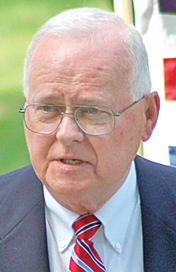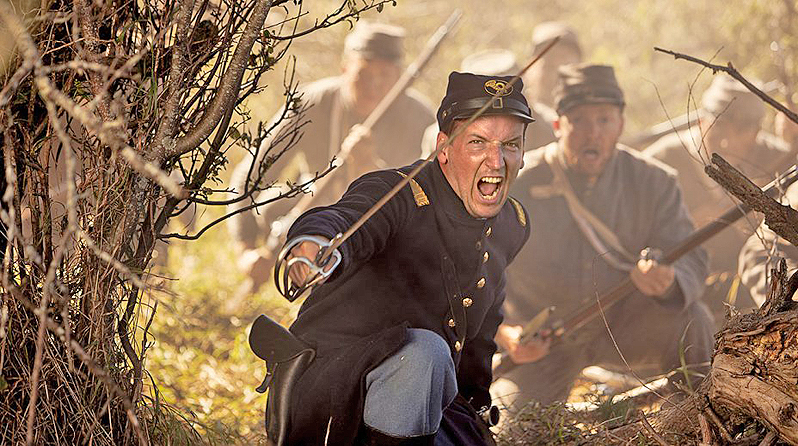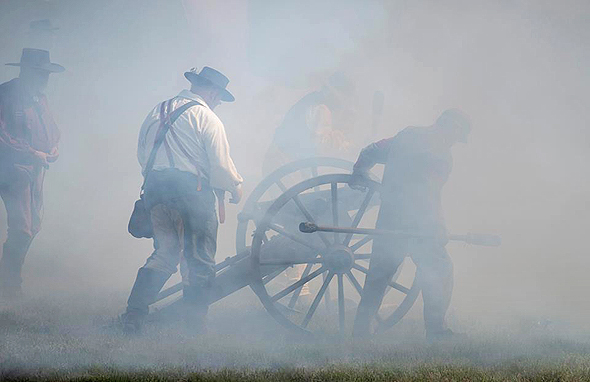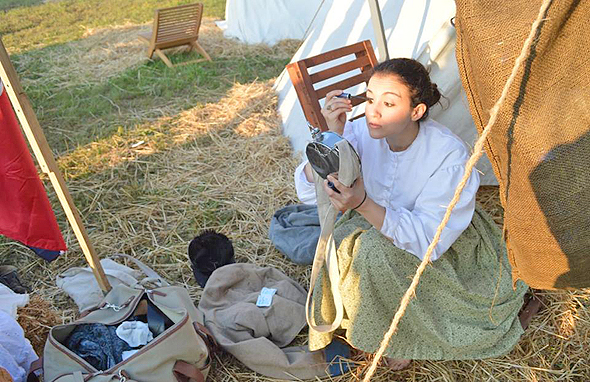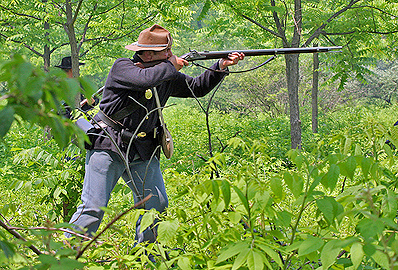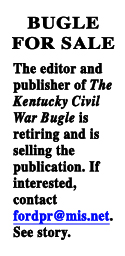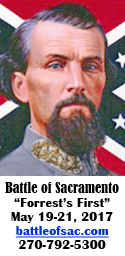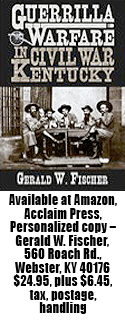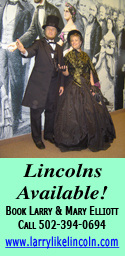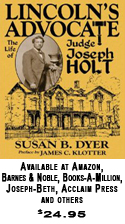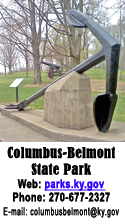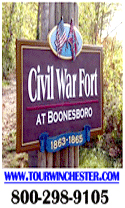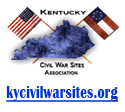|
Grant’s historical black mark revoked
thanks to Paducah Jewish merchant
The up-and-down career of General and former U.S. president Ulysses S. Grant was marred by one of the most severe anti-Semitism episodes in American history.
In December 1862, Grant, then a Union brigadier general, issued General Order No. 11, which expelled all Jews from Kentucky, Tennessee and Mississippi. The order was intended as a punishment for Jewish merchants who were viewed as violating regulations of trade concerning a black market in Southern cotton. More
Random thoughts on slavery …
It began in colonies in 1592, but many
were native Americans, plus Irish
By DOUG LIPPMAN
Bugle Staff Writer
We Americans like simple, short solutions to complex problems. The tendency to oversimplify has become a national idiosyncrasy. Such is the case with the complex institution which we refer to as slavery. Few subjects are as complicated as slavery, yet we still insist on simple explanations when discussing it.
Today most people consider slavery barbaric, but this was not always the case. In the ancient world, before slavery existed, if the army of town A defeated the army of town B, it was customary for town A’s army to enter town B and slaughter all inhabitants, men, women and children. Eventually, a new “humanitarian” idea altered this tactic, and slavery was introduced. Yes, it then was considered a humanitarian alternative to obligatory massacres. More
Bugle editorial ...
Everything has beginning, end; it’s time
for editor, publication to designate 30
Nothing lasts forever.
And so it is with The Kentucky Civil War Bugle.
After 10 years and the editor’s 80th birthday, it’s time for the publication and me to step aside.
The Bugle, published four times a year in January, April, July and October, was introduced in a tabloid format in January 2007. It was changed to an electronic format and continued until the present as an online publication. It has grown – as best as we can figure – to a readership of some 20,000. That’s from coast-to-coast and in two foreign countries – Great Britain and Australia. More
Bugle book review…
If Grant had not taken Paducah, could
outcome of Civil War been different?
(PADUCAH AND THE CIVIL WAR, by John Philip Cashon, 118 pages with notes, bibliography and index, The History Press 2016, paperback $21.99)
By ED FORD
Bugle Editor
Author John Philip Cashon offers an interesting and, possibly, a very valid point about Paducah in the Civil War.
He contends U.S. Grant’s successful takeover of Paducah in September 1861 was, perhaps, the single most important move the Union general made during the war. More
Boone-founded 28th Kentucky Infantry
saw important action throughout war
By BRYAN BUSH
Bugle Staff Writer
Union Col. William P. Boone and his son, Col. John Rowan Boone, formed and led the 28th Kentucky Infantry in some of the bloodiest campaigns of the Civil War.
The 28th, under their leadership, saw action in Tennessee, Georgia, Alabama, Louisiana and Texas. From 1861 until being mustered out in January 1866, the regiment lost a total of 112 men during the war.
Some of the key engagements were in Munfordville, Atlanta, Resaca, Kennesaw Mountain, Franklin and Nashville. More
War has its own language, then makes
its way into modern everyday usage
War affects everything. Even words and language.
Here are eight examples that emerged from the Civil War.
Deadline
In Civil War military prisons, the “dead line” referred to the line drawn around a prison outside of which prisoners were liable to be shot.
In 1920s journalism slang, it became the time by which material had to be ready for inclusion in a particular issue of a publication. More
|
|
|
|
Bugle Briefs ...
9,000 students have visited battlefields,
historic sites through Field Trip Fund
Through its Field Trip Fund, the Civil War Trust has sent 9,000 young people to battlefields and historic sites in 18 sites across the country. The Trust continues to receive applications every week from teachers who want to take their students to visit America’s hallowed ground. These outdoor classrooms are designed to make Civil War history come alive and makes battlefield field trips available to those who may otherwise not be able to make such a trip.
The field trip fund depends upon contributions from interested donors. Garry Adelman, director of the Trust’s History and Education department, points out that a $40 donation allows two youngsters to visit a battlefield. A $100 gift provides for five visitors, $200 for 10, $500 for 25 and a full classroom, and $1,000 funds 50 and two-three classrooms.
Contributions are made through the Trust’s web site – www.civilwar.org – or by sending a check to Civil War Trust, 1140 Professional Court, Hagerstown, MD 21740. Adelman can be contacted at gadelman@civilwar.org or by calling 1-888-606-1400. More
Kentucky flintlock, America’s first rifle,
paved way for long guns of Civil War
Even before there was actually a “United States” there was what could arguably be considered the first true “American rifle.”
Known as the Pennsylvania rifle, the Kentucky rifle or simply the long rifle, it was designed for hunting and was characterized by an unusually long barrel, a unique development that was uncommon in the European rifles of the era.
Military history consultant and former United States Marine Corps Captain Dale Dye explains that in the flintlock era, the long gun was the first to have grooves in the barrel.
“These grooves, or rifling, along with the longer barrel, made the guns much more accurate than the British Brown Bess musket,” he said. More
U of L Confederate monument moved
to Brandenburg after lengthy debate
A controversial 121-year-old Confederate monument at the University of Louisville has been moved to Brandenburg after a long debate about its removal.
The decision came seven months after a heated discussion between Louisville Mayor Greg Fischer and former U of L President James Ramsey.
“This new location provides an opportunity to remember and respect our history in a more proper context,” Fischer said. “And it’s close enough that Louisvillians can visit.”
Fischer made the decision on moving the city-owned monument after reviewing a list of recommendations from the city’s arts commission. Some two dozen representatives, some as far away as Virginia, said they would welcome the monument. The mayor said many factors influenced his decision, including Brandenburg’s desire to use the statue as part of its biennial Civil War re-enactment, as well as the city’s location along the Ohio River, just 44 miles from Louisville. More
More discussion needed before symbols
of Confederacy are deleted, removed?
“Communities throughout the United States are in the midst of a widespread reconsideration of symbols of the Confederacy and white supremacy,” Modupe Labode acknowledges.
The associate professor of History and Museum Studies at Indiana University-Purdue University Indianapolis notes that arguments over these symbols and calls for monument removals are nothing new. Protests over the display of Confederate monuments and emblems go back decades, he says.
Because the discussions of Confederate monuments are local and engage with interpretations of the past, institutions concerned with local and state history could and, perhaps, should be involved in their communities as they contend with these issues, he continued. More
Kentucky’s Civil War leaders ...
CSA Gen. Hawes chose military career
rather than family’s political service
(EDITOR’S NOTE: This is the 38th in a series about Kentucky’s officers and battle leaders during the Civil War.)
Lexington-born Confederate officer James Morrison Hawes came from a politically prominent family.
His father, Richard, uncle Albert, great-uncle Aylett and cousin Aylett Hawes Buckner all served in the U.S. House of Representatives. But James Hawes saw his career developing in another direction. More
|
|
|
